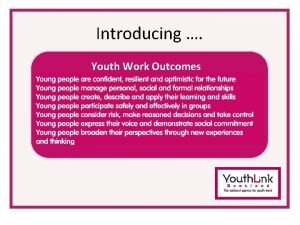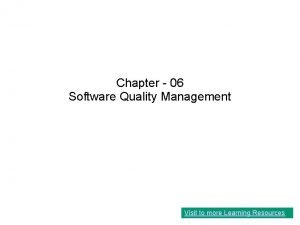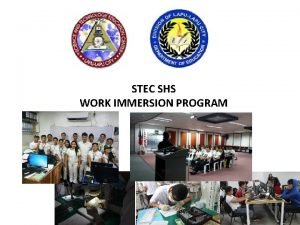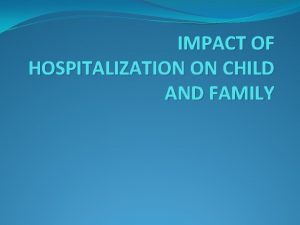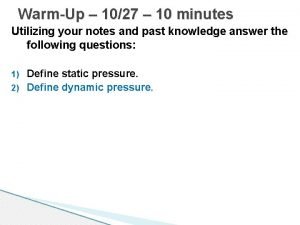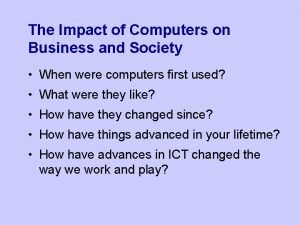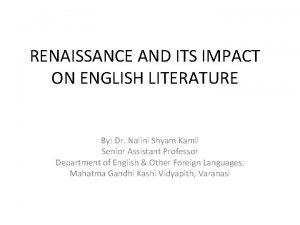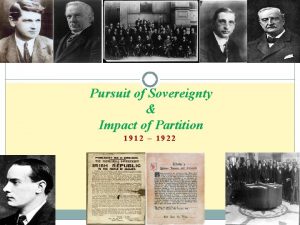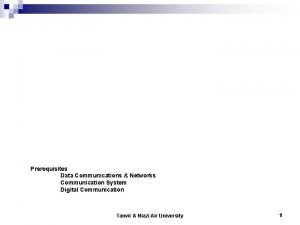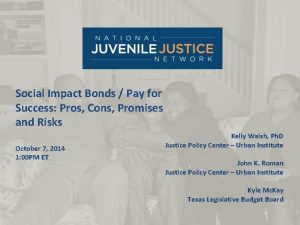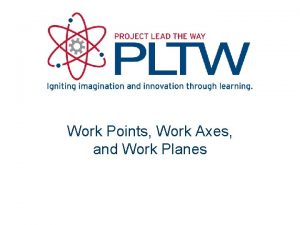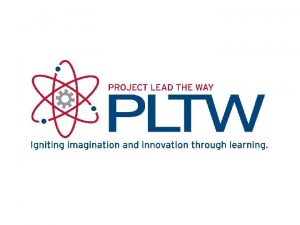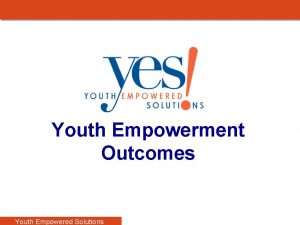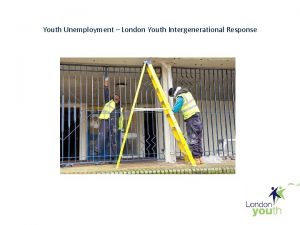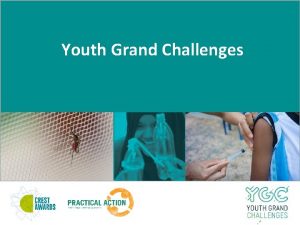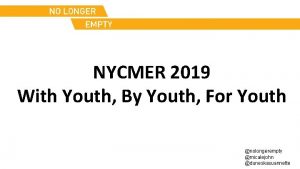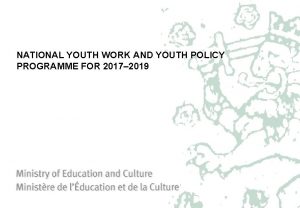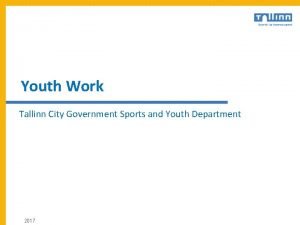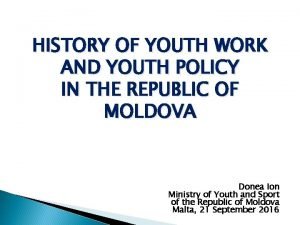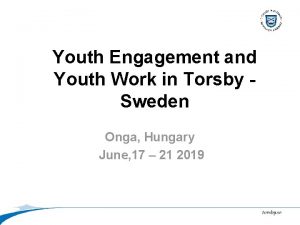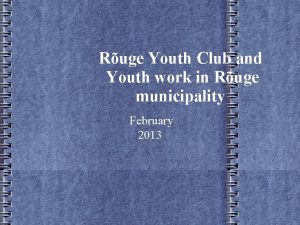Quality and impact of youth work in youth





































- Slides: 37

Quality and impact of youth work in youth centers - the Finnish experience - The situation in Finland how we got where we are now Starting with the legislation and the structures and roles Case Kanuuna and the biggest municipalities in the country Presentation of the Finnish youth centres Presentation of Villa Elba Quality and impact in the youth centres Scorecard Next step: a new system Final remarks

Youth Work and Youth Policy in Finland - Young people started to found youth associations 1881 Ø A part of the national awakening – an self governing area 1809 and independence 1917 - First youth legislation 1972 ; aim to create possibilities for young people at their free time - Present legislation is from 2016 http: //minedu. fi/en/legislation-youth Ø support young people’s free-time pursuits and engagement in civic society Ø promote the social inclusion of young people Ø improve young people’s growth and living conditions

Definitions for the purpose of the legislation - young people: under 29 years of age - youth work: the efforts to support the growth, independence and social inclusion of young people in society - youth policy: coordinated actions to improve young people's growth and living conditions and interaction between the generations - youth activities: spontaneous action taken by young people themselves - national youth work organisation means a registered association or foundation providing activities or services based on the principles of this Act http: //minedu. fi/en/youthorganisations - national youth work centre of expertise means an entity that seeks to develop and promote competence and expertise in youth-related issues on a nationwide basis - youth centres to provide services and to develop methodologies for youth work http: //minedu. fi/en/national-youth-centres

Definitions for the purposes of the legislation 2 - Youth Policy Programme for the period of running (four years) - specifies more detailed objectives for the national youth work and policy and the support to be provided for these efforts - prepared by the Ministry of Education and Culture and young people and key actors engaged in youth work and policy are to be consulted http: //minedu. fi/en/policies-and -development-youth - Key objectives 2017 - Statistics and more http: //www. nuorisotilastot. fi (also in English) All children and young people will have a possibility to engage in at least one freetime hobby of their choice; Young people’s employability skills will be reinforced; More opportunities for participation and exerting influence will be created for young people; Fewer young people will suffer from mental health problems, thanks to preventive work; and Young people will be provided with sufficient guidance and other support for independent living.

Structures and responsibilities - The Ministry of Education and Culture is responsible for the overall administration, coordination and development of the national youth policy, and for the creation of favourable conditions for the pursuit of this policy within the central government www. minedu. fi/en - Regional state administrative agencies are responsible for: - developing the national youth work and policy in the local context - granting state aid and assessing the impact of the aid granted - issuing informative guidelines - gathering information on youth work and policy - assessing the quality and accessibility of the services intended for young people https: //www. avi. fi/en/web/avi-en/

Structures and responsibilities 2 Local governments (municipalities) have the task to create the conditions for local youth work and activities by: Ø providing services and premises for young people Ø supporting their civic engagement in cooperation with others Ø establish a cross-sectoral steering and service network to address issues related to young people https: //www. kokkola. fi/etusivu/en_GB/etusivu/ Youth Centres Ø Eligibility given by the Ministry of Education and Culture (for state aid) Ø Preconditions for the financing: - the centre pursues the objectives and promotes the principles set out in the Act - the youth centre’s main activity is to offer young people guided adventures, nature- or environment-related or cultural or camping activities - the youth centre shall seek to promote the international orientation of young people and sustainable development http: //www. snk. fi/finnish-youth-centre-network. html and http: //www. villaelba. fi/en/en_GB

Structures and responsibilities 3 State Youth Council - working together with the Ministry of Education and Culture, members appointed by the Government - task to address issues, make initiatives and proposals, keep up-to-date information on young people and their living conditions, issue statements and monitor international development and cooperation in the sector Local Youth Council - Local Government Act (2015) made it mandatory to have Youth Councils in every municipality in Finland; at the moment 70% of municipalities have a local youth council - task to represent young people in municipality and make young people’s voices heard - co-operate with each other under the umbrella of the Union of Finnish Youth Councils

Structures and responsibilities 4 - Allianssi is a national organisation for youth work services and influence Ø 125 members: national youth and educational organisations - The Finnish Youth Research Society Ø purpose of promoting multidisciplinary youth research in Finland providing information and expertise on matters relating young people - studies, perspectives, interpretations and political stands https: //www. youthresearch. fi/

Structures and responsibilities 5 - Youth workshops - support young people aged under 29 in tackling issues related to education and training, working life and life management - work-oriented and learning environments - these activities are organised by municipalities, associations and foundations among other things ant are available in over 90% of all municipalities https: //www. tpy. fi/jarjesto/briefly-in-english/ - Outreach youth work - assists young people under the age of 29 who are excluded from education and working life or who need support in accessing the services they need - municipalities decide whether or not to organise outreach youth work, today these activities cover more or less the entire country

Quality Youth Work in Finland, case Kanuuna The Kanuuna (Cannon) Network - Finnish network of local youth work - a national youth work centre of expertise - 27 biggest cities and 60% of the young people - main activities: v support peer learning in youth work and youth policy v carry out research and development projects and v function to stand for and be an expert of youth work and young people v http: //www. nuorisokanuuna. fi/what

Quality Youth Work in Finland: case Kanuuna 2 - indicators and quality assessment Why: increasing pressure to prove its outcomes and its quality Opponent: some strongly oppose ‘the measurement tendency” Kanuuna network has developed a set of indicators to make its youth work transparent, to assess and develop it statistical indicators on key activities (number of visits, group work activities, long-term support of youth at risk, camping activities, on-line contacts, camps, number of youth organizations and their members etc. ) statistical info about the youth services of the member cities key indicators of the welfare of young people based on a large national School Health Survey quality assessment data of open youth work using the tool described next

Quality youth work in Finland: case Kanuuna 3 ”youth work quality assessment” - publication http: //www. nuorisokanuuna. fi/sites/default/files/filedepot/youth_work_quality_assessment_verkkoversio. pdf

Finnish Youth Centres - Start: the Conference for Security and Cooperation in Europe in 1975: How to support national and international mobility of youth? - established between 1982 and 2000, today 9 centres - centres are specialised: e. g. Villa Elba international youth work and environmental education - good quality services and facilities at reasonable prices - experts in non-formal education

Finnish Youth Centres 2 Youth centre pedagogy: a common educational approach to work with children and young people - based on humanistic idea of man and experimental learning in surroundings characteristic for youth centres: - welcoming, respectful, nature-loving with excellent facilities for experimental learning in groups Common for the centres: - Services related to camp schools, nature schools and environmental education, youth camps and youth events, family and recreational holidays, safe environment - Social youth work – Nuotta coaching for the youth workshops and outreach youth work - regional and national development projects on youth work - international youth work - each centre have its own administration and economy and offers services based on local strengths

Youth Center Villa Elba Location History - summer house tradition area since 1860's - 1960’s summer camp area - international youth centre since 1991 Organisation - owned by the municipality of Kokkola - staff: 15 permanent and person-years approx. 19 - expert, service and administration teams -

Youth Centre Villa Elba 2: activities

Quality and impact of youth centres Overall level - youth work in the centers in Finland also in municipal youth work traditionally more doing than theory and documents - in youth centers difficult to define what result comes from what action (school, family etc. ) because of the nature of the activity and the duration - easier to measure quantity and these indicators are well developed - no clear demand from the decision makers and the ministry to also measure impact and quality of the work

Finnish Youth Centres Quality Work - started in 2016 when the Ministry of Education and Culture initiated this work (also in other networks) - all centres represented by “quality persons” in the working group; also staff from the association, me technical chairperson - the models in the beginning was: Ø Quality Label for Youth Centres criteria Ø Kanuuna networks (at that time) level descriptions - aim to create own tool for the quality work with three levels: excellent, good and satisfying - this to encourage the centres to develop the satisfying parts - also a tool for the Ministry in decision-making and evaluation

Finnish Youth Centres Quality Work 2 - unrealistic time schedule - staff (association) did not have enough know-how (1 administrator, 1 intern) - the members representing the centres did not have enough know-how (instructors, janitor etc. ) - difficulties to find common ground within the working group Ø different ways of working Ø lack of know-how - 2017 new direction for the work (new staff at the association) scorecard Ø Initial phase: the level descriptions were a solid part of it Ø Final phase: a minimum level scorecard was achieved, based on the legislation’s requirements

Finnish Youth Centres Scorecard Areas - Good quality camp activities - International youth work - Sustainable development and environmental responsibility - Regional development of youth work - Impact in society and ability to serve - How to make youth centres better known and communication - Economy in youth work Matrix - objectives; evaluation criteria & indicators; means; results; development actions, responsible person & time schedule

Finnish Youth Centres Scorecard Not an official translation!












Next step: a new system for monitoring & evaluation of youth centres activities - Ministry outsourcing the work to the Youth Centre Association project - Why? : the need for monitoring and evaluation is increasing in all activities - Public financing – how is it used and what does it bring - The new Youth Act and the Government’s Decree state that centres need to have a system in place for monitoring and assessing its own activities - Non-profit activities and business activities (with revenue) are kept apart - Competition neutrality - Digitalization - The current system is old fashioned and takes a lot of time - Requirements: - Easy to use and cloud computing - Easy to develop when new demand arise - Might be integrated with other systems in the future e. g. reservation systems

Not an official translation!


Final remarks - youth centres are very good at measuring quantity; the association have an exel for every possible question - youth centres do not seem to have interest in measuring quality of the work at group and youngster/individual level Ø is there a belief that if you measure quantity the quality is measured at the same time? Ø the chief operating managers often do not have a background in youth work – is there enough know-how? - the quality label criteria were not embraced - the instructions from the Ministry were not generous - the view is often some kind of “average thinking” - the new system does not have a quality aspect

Thank you!
 Quality control and quality assurance
Quality control and quality assurance Concept of quality assurance
Concept of quality assurance London youth quality mark
London youth quality mark Section 4 review physical science
Section 4 review physical science Quality management pmp
Quality management pmp Quality metrics pmp
Quality metrics pmp Quality assurance model in nursing management
Quality assurance model in nursing management Quality improvement vs quality assurance
Quality improvement vs quality assurance Quality gurus meaning
Quality gurus meaning Quality is free: the art of making quality certain
Quality is free: the art of making quality certain What is tqm
What is tqm Youth work outcomes
Youth work outcomes Hard work or smart work
Hard work or smart work Physics 03-06 impulse and momentum answer key
Physics 03-06 impulse and momentum answer key Six sigma methodology defines three core steps
Six sigma methodology defines three core steps Work immersion portfolio design
Work immersion portfolio design Work immersion ethics
Work immersion ethics Present continuous tense of work
Present continuous tense of work Social group work model
Social group work model The components of social case work
The components of social case work Work group vs work team
Work group vs work team I work all night i work all day to pay the bills
I work all night i work all day to pay the bills Smart work vs hard work group discussion
Smart work vs hard work group discussion Shs work immersion
Shs work immersion Mst physics 1135
Mst physics 1135 Impact of hospitalization on the child and family
Impact of hospitalization on the child and family Top ten risk item tracking
Top ten risk item tracking Impact pressure chamber and lines
Impact pressure chamber and lines Impact of computers on business
Impact of computers on business Renaissance characteristics
Renaissance characteristics Pursuit of sovereignty and impact of partition essays
Pursuit of sovereignty and impact of partition essays Digital communications and networks
Digital communications and networks Social impact bonds pros and cons
Social impact bonds pros and cons Materi kuliah manajemen resiko
Materi kuliah manajemen resiko Lesson 5 the slave trade and its impact on africa
Lesson 5 the slave trade and its impact on africa What is the scope and economic impact of agribusiness
What is the scope and economic impact of agribusiness Scope of agribusiness
Scope of agribusiness What is the scope and economic impact of agribusiness?
What is the scope and economic impact of agribusiness?











